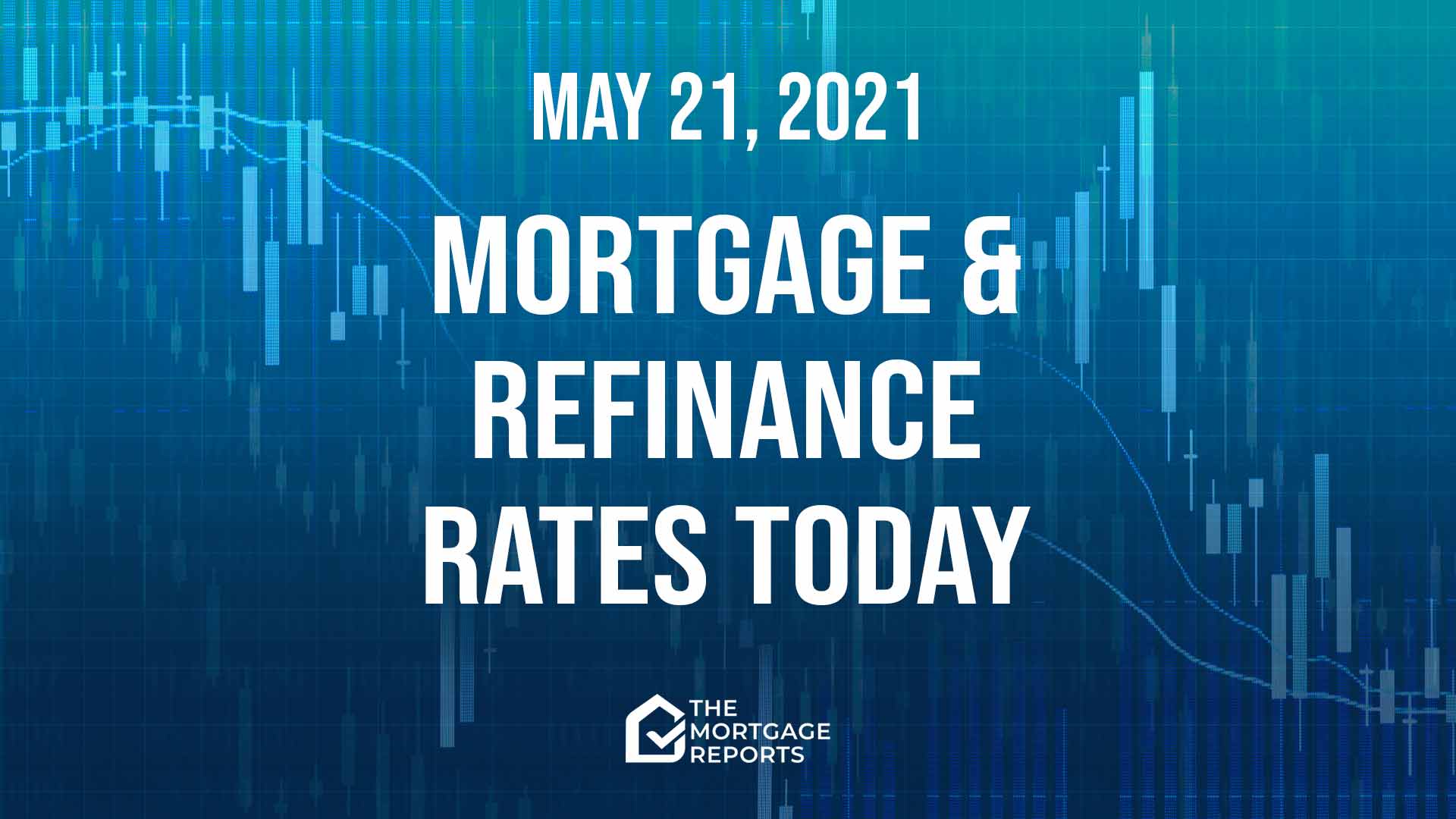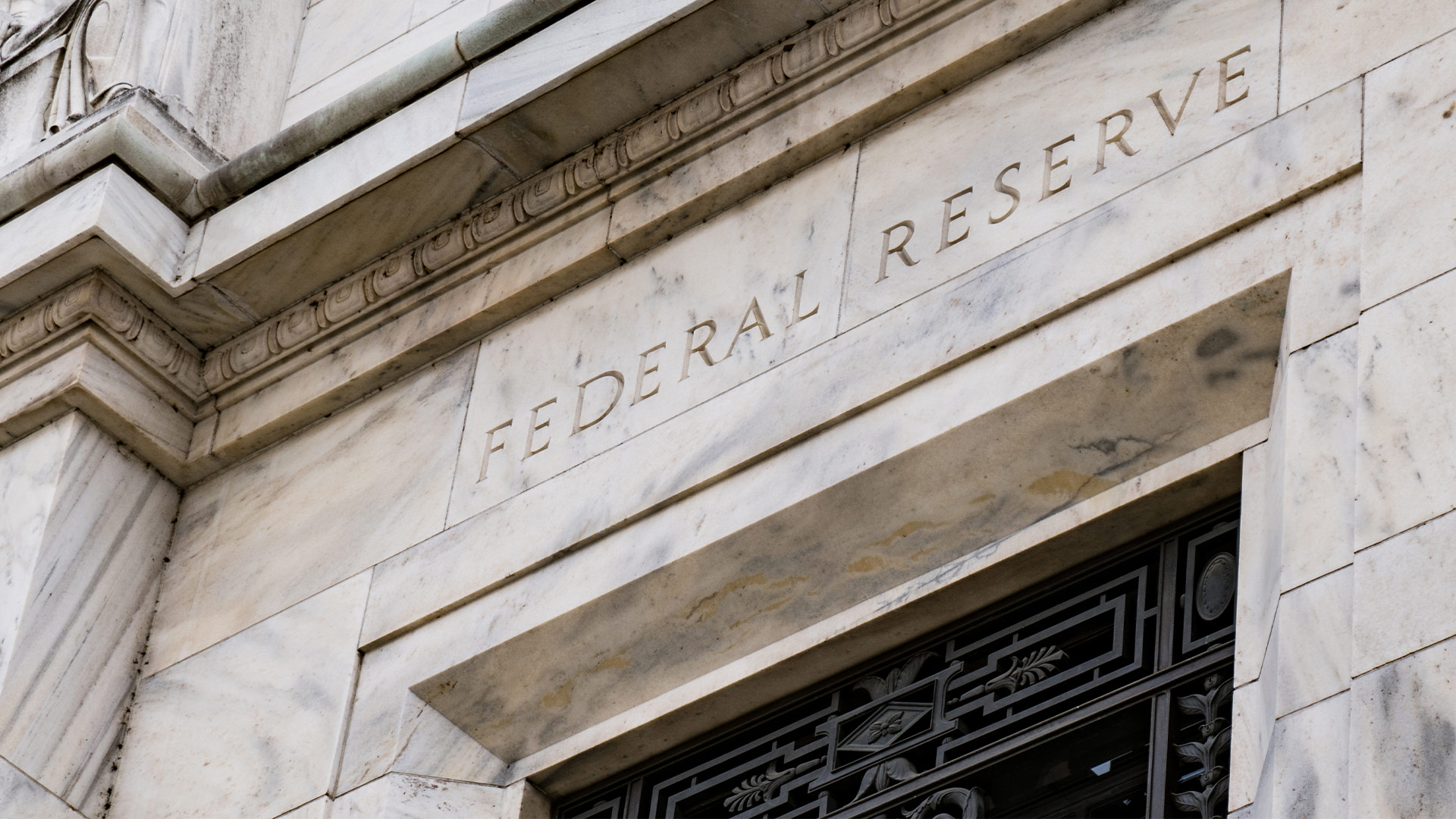
Today’s mortgage and refinance rates
Average mortgage rates edged lower yesterday. The trouble is, that makes just two falls over the last nine business days.
First thing, it was looking as if mortgage rates today might edge lower again or hold steady.
Find and lock a low rate (May 24th, 2021)Current mortgage and refinance rates
| Program | Mortgage Rate | APR* | Change |
|---|---|---|---|
| Conventional 30 year fixed | |||
| Conventional 30 year fixed | 3.103% | 3.108% | Unchanged |
| Conventional 15 year fixed | |||
| Conventional 15 year fixed | 2.25% | 2.367% | -0.03% |
| Conventional 20 year fixed | |||
| Conventional 20 year fixed | 2.813% | 2.904% | -0.03% |
| Conventional 10 year fixed | |||
| Conventional 10 year fixed | 1.833% | 2.059% | -0.08% |
| 30 year fixed FHA | |||
| 30 year fixed FHA | 2.814% | 3.472% | Unchanged |
| 15 year fixed FHA | |||
| 15 year fixed FHA | 2.498% | 3.098% | Unchanged |
| 5 year ARM FHA | |||
| 5 year ARM FHA | 2.5% | 3.201% | Unchanged |
| 30 year fixed VA | |||
| 30 year fixed VA | 2.375% | 2.547% | -0.13% |
| 15 year fixed VA | |||
| 15 year fixed VA | 2.25% | 2.571% | Unchanged |
| 5 year ARM VA | |||
| 5 year ARM VA | 2.5% | 2.379% | Unchanged |
| Rates are provided by our partner network, and may not reflect the market. Your rate might be different. Click here for a personalized rate quote. See our rate assumptions here. | |||
COVID-19 mortgage updates: Mortgage lenders are changing rates and rules due to COVID-19. To see the latest on how coronavirus could impact your home loan, click here.
Should you lock a mortgage rate today?
In spite of yesterday’s modest fall, mortgage rates have been heading higher since the start of May. Of course, they might change course and head lower again.
But I don’t see many reasons to believe that’s likely to happen in a sustained way. And there are plenty more — and more compelling — reasons to think they’ll carry on moving higher.
So my personal rate lock recommendations remain:
- LOCK if closing in 7 days
- LOCK if closing in 15 days
- LOCK if closing in 30 days
- LOCK if closing in 45 days
- LOCK if closing in 60 days
However, I don’t claim perfect foresight. And your personal analysis could turn out to be as good as mine — or better. So you might choose to be guided by your instincts and your personal tolerance for risk.
Market data affecting today’s mortgage rates
Here’s a snapshot of the state of play this morning at about 9:50 a.m. (ET). The data, compared with roughly the same time yesterday, were:
- The yield on 10-year Treasurys edged down to 1.63% from 1.65%. (Good for mortgage rates.) More than any other market, mortgage rates normally tend to follow these particular Treasury bond yields, though less so recently
- Major stock indexes were higher on opening. (Bad for mortgage rates.) When investors are buying shares they’re often selling bonds, which pushes prices of those down and increases yields and mortgage rates. The opposite may happen when indexes are lower
- Oil prices rose to $63.59 from $62.84 a barrel. (Bad for mortgage rates*.) Energy prices play a large role in creating inflation and also point to future economic activity.
- Gold prices increased to $1,889 from $1,875 an ounce. (Neutral for mortgage rates*.) In general, it’s better for rates when gold rises, and worse when gold falls. Gold tends to rise when investors worry about the economy. And worried investors tend to push rates lower
- CNN Business Fear & Greed index — rose to 37 from 35 out of 100. (Bad for mortgage rates.) “Greedy” investors push bond prices down (and interest rates up) as they leave the bond market and move into stocks, while “fearful” investors do the opposite. So lower readings are better than higher ones
Caveats about markets and rates
Before the pandemic and the Federal Reserve’s interventions in the mortgage market, you could look at the above figures and make a pretty good guess about what would happen to mortgage rates that day. But that’s no longer the case. We still make daily calls. And are usually right. But our record for accuracy won’t achieve its former high levels until things settle down.
So use markets only as a rough guide. Because they have to be exceptionally strong or weak to rely on them. But, with that caveat, so far mortgage rates today look likely to edge lower again or barely move. However, be aware that intraday swings (when rates change direction during the day) are a common feature right now.
Find and lock a low rate (May 24th, 2021)
Important notes on today’s mortgage rates
Here are some things you need to know:
- Typically, mortgage rates go up when the economy’s doing well and down when it’s in trouble. But there are exceptions. Read ‘How mortgage rates are determined and why you should care
- Only “top-tier” borrowers (with stellar credit scores, big down payments and very healthy finances) get the ultralow mortgage rates you’ll see advertised
- Lenders vary. Yours may or may not follow the crowd when it comes to daily rate movements — though they all usually follow the wider trend over time
- When daily rate changes are small, some lenders will adjust closing costs and leave their rate cards the same
- Refinance rates are typically close to those for purchases. But some types of refinances are higher following a regulatory change
So there’s a lot going on here. And nobody can claim to know with certainty what’s going to happen to mortgage rates in coming hours, days, weeks, or months.
Are mortgage and refinance rates rising or falling?
Today and soon
Overnight, CNN Business’s Nightcap e-newsletter playfully addressed the current debate among economists on future inflation.
On the one hand, the Federal Reserve reckons price rises are “transitory” and will soon moderate once the sugar rush of government checks dissipates. Nightcap put it thus:
Prices are going up across the board as the economy emerges from the trash tornado that was 2020. Wages are rising. So are bond yields. The housing market is on fire. That’s all good news — as long as the increases are in fact “transitory” and not — what’s the word? — barreling on like a freight train from hell.
However, the article continues:
[Fed Chair Jerome] Powell’s devotion to the “transitory” narrative signals to some analysts that the central bank is underestimating the strength of the rebound and the potential for the kind of sky-high inflation the US hasn’t seen since the late 1970s and early 1980s.
— CNN Business Nightcap, “IN POWELL WE TRUST,” April 20, 2021
Most interestingly, the article reckons, ” … investors are pricing in only about an 11% chance of a rate hike [of the Fed’s own rates; not mortgage rates] by the end of the year.” But that’s likely to change — up or down or both — as inflation data are released.
If investors reckon the chances of sustained inflation are rising, you’re almost bound to see higher mortgage rates. So let’s hope Mr. Powell is right.
Mortgage rates and inflation: Why are rates going up?
For more background, check out our latest weekend edition of this report.
Recently
Over much of 2020, the overall trend for mortgage rates was clearly downward. And a new, weekly all-time low was set on 16 occasions last year, according to Freddie Mac.
The most recent weekly record low occurred on Jan. 7, when it stood at 2.65% for 30-year fixed-rate mortgages. But then the trend reversed and rates rose.
However, those rises were mostly replaced by falls in April, though those moderated during the second half of that month. And May has so far seen rises outweighing falls. Freddie’s May 20 report puts that weekly average at 3.0% (with 0.6 fees and points), up from the previous week’s 2.94%.
Expert mortgage rate forecasts — Updated today
Looking further ahead, Fannie Mae, Freddie Mac and the Mortgage Bankers Association (MBA) each has a team of economists dedicated to monitoring and forecasting what will happen to the economy, the housing sector, and mortgage rates.
And here are their current rates forecasts for the remaining quarters of 2021 (Q2/21, Q3/21, Q4/21) and the first quarter of 2022 (Q1/22).
The numbers in the table below are for 30-year, fixed-rate mortgages. Fannie’s were updated on May 19 and the MBA’s on May 21. Freddie’s forecast is dated April 14. But it now updates only quarterly. So expect its numbers to begin to look stale soon.
| Forecaster | Q2/21 | Q3/21 | Q4/21 | Q1/22 |
| Fannie Mae | 3.0% | 3.1% | 3.2% | 3.3% |
| Freddie Mac | 3.2% | 3.3% | 3.4% | 3.5% |
| MBA | 3.1% | 3.3% | 3.5% | 3.7% |
However, given so many unknowables, the current crop of forecasts might be even more speculative than usual.
Find your lowest rate today
Some lenders have been spooked by the pandemic. And they’re restricting their offerings to just the most vanilla-flavored mortgages and refinances.
But others remain brave. And you can still probably find the cash-out refinance, investment mortgage or jumbo loan you want. You just have to shop around more widely.
But, of course, you should be comparison shopping widely, no matter what sort of mortgage you want. As federal regulator the Consumer Financial Protection Bureau says:
Verify your new rate (May 24th, 2021)Shopping around for your mortgage has the potential to lead to real savings. It may not sound like much, but saving even a quarter of a point in interest on your mortgage saves you thousands of dollars over the life of your loan.



